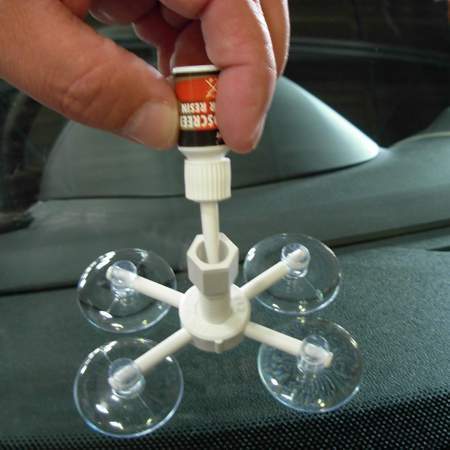11th Aug 2017
How to do a DIY windscreen repair to small chips and cracks
With all the rain we are having this summer in the UK it makes road conditions more hazardous for driving. Puddles of water form with the risk of aquaplaning, stones wash across the road and pot holes get deeper. Adverse weather conditions can result in accidents and stones being flicked up and cracking a vehicles windscreen.
The best advice is to get stone chips or cracks to your windscreen repaired as soon as possible. If left untreated it could spread and become an expensive windscreen replacement. A windscreen chip of more than 10mm in the drivers line of vision will result in an MoT failure. Driving with a cracked, chipped or damaged windscreen constitutes use of vehicle in a dangerous condition which is an offence under section 40 of the Road Traffic Act. If caught you could get a fixed penalty of 3 points on your license and a fine.
There are 7 types of windscreen cracks as described here:
- Bull's eye - circular crack from debris or a small rock flung up from the tyres of a passing vehicle. Depending on the size, they are repairable. If too big, a complete replacement is required.
- Half-moon - semi-circular and is also caused by the impact of a round object.
- Star break - small cracks leading away from the point of contact. If left, they could spread and require windscreen replacement.
- Edge crack - starts within 2" of the edge of a windscreen
- Stress crack - caused by a sudden change in temperature (using boiling water to de-frost a windscreen!)
- Chip - when the impact of an object causes small pieces of glass to come off the windscreen
- Floater crack - crack starting in the middle of a windscreen at least 2" away from the edge. If not too deep it is repairable.
For cracks not longer than 30cm or chips no bigger than 25cm these can be repaired by injecting a durable resin into the area of windscreen damage. This will stop the crack spreading, Repairing rather than replacement of a windscreen is also kinder to the environment as well as to your pocket.
For small chips or cracks you can repair these yourself with a DIY windscreen repair kit. It comes complete with detailed instructions and everything you need to make the repair. The job takes just minutes saving you time and money.
Windscreen repair for small cracks and stone chips
This is an overview of how to use the DIY windscreen repair kit. Full details will be sent to customers with their order.
- The initial work should be done out of direct sunlight

- Clean your windscreen - be careful not to add pressure to your windscreen while washing away the dirt and grime
- Use the razor blade included in the kit to remove any loose fragments of glass
- Attach the applicator base to the windscreen centring the ring above the crack or chip. Make sure the suction cups are firmly attached to the glass
- Screw the resin chamber into the centre ring until the rubber mouth comes into contact with the glass
- Squeeze a few drops of repair resin into the chamber
- Allow the repair resin time to be absorbed into the crack or chip (usually about 4 to 6 minutes depending on the extent of the damage).
- Unscrew and remove the pressure driver, re-insert and repeat until satisfactory results are achieved
- Remove apparatus, touch-up and apply curing strips to the repair
- When complete move your car into direct sunlight to allow the resin to cure completely for ten minutes and then remove curing strips. Or, leave until repair resin is dry and then remove
- Scrape away hardened excess resin with the razor blade from the windscreen repair kit
It is not just the impact of an object flung up on a windscreen or exposure to extreme temperatures that could cause chips or cracks to a windscreen, but even the wiper blades can damage the glass. The sun shining on hair-line scratches caused by wiper blades can severely impair a drivers vision. Using a glass repair and polish product such as Rejel's DIY windscreen light scratch repair and polish kit will restore your windscreen to perfection.
A windscreen offers structural support to a car and protects the occupants from flying debris, so carrying out repairs or a complete replacement ensures safe driving.
